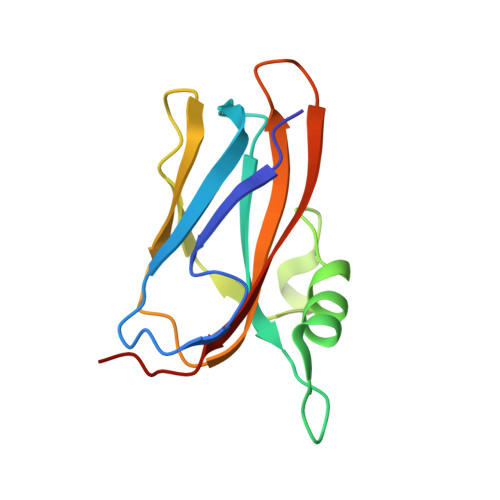CopC as a potential metallochaperone delivering copper ions to the active site of a thiocyanate dehydrogenase.
Solovieva, A.Y., Kulikova, O.G., Varfolomeeva, L.A., Dergousova, N.I., Boyko, K.M., Khrenova, M.G., Tikhonova, T.V., Popov, V.O.(2025) Int J Biol Macromol 322: 146801-146801
- PubMed: 40812657
- DOI: https://doi.org/10.1016/j.ijbiomac.2025.146801
- Primary Citation of Related Structures:
8YTR - PubMed Abstract:
The CopC proteins are periplasmic copper binding proteins involved in bacterial copper homeostasis. One of the supposed functions of СopСs is to deliver copper ions for incorporation into the active sites of copper-containing oxidoreductases. In the sulfur oxidizing bacterium Thiolkalivibrio paradoxus, the genes encoding the CopCD proteins are located near the gene encoding the enzyme thiocyanate dehydrogenase (TcDH) containing three copper ions in the active site. The biochemical characterization demonstrated that CopC from Tv. paradoxus (tpCopC) has a high affinity for copper ions in both oxidation states (log K D = -16.3 ± 0.6 for Cu(II) and -11.1 ± 0.2 for Cu(I)). The protein Cu(II)-tpCopC forms a transient complex with TcDH, in which a copper ion could be transferred from tpCopC to the active site of TcDH. In the absence of a reducing agent, the transfer of 0.5 ± 0.2 copper ions is observed; under reducing conditions, the transfer of 2.4 ± 0.1 copper ions takes place followed by the activation of TcDH. Thus, CopC can act as a metallochaperone, providing the incorporation of copper ions into the active site of TcDH. The mechanism is proposed for the copper ion transfer from Cu(II)-tpCopC to TcDH through the intermediate reduction to form Cu(I)-tpCopC.
- Federal Research Centre "Fundamentals of Biotechnology" of the Russian Academy of Sciences, Leninsky prospect, 33, build. 2, Moscow 119071, Russian Federation. Electronic address: nastya.soloveva1@yandex.ru.
Organizational Affiliation:


















